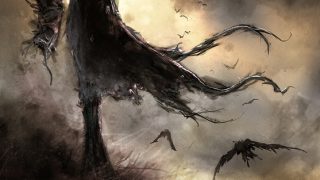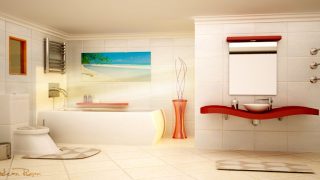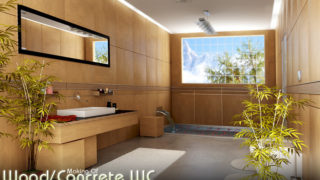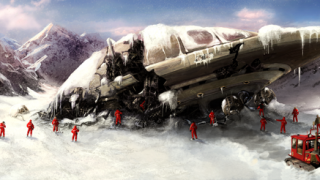
Making of the Conall
First and most important part is to imagine what you have to or what you want to create. After few hours I’ve chosen to sculpt werewolf. It’s half human, half animal and it has clothes. So many different issues to face up.
IntroductionAbout 18 months ago I was looking for some online workshop to learn how to sculpt digitally, I wanted some workshop which really teaches you sculpting and not how to control your program, you can learn it from manual, but sculpting itself is about skill and experiences. I found that well-known sculptor Alex Oliver (http://www.alexoliver.art.br) is giving workshop like that. He taught me basics of sculpting and completely overturned my attitude to modeling. I found that it’s much easier for me to block out very basic box mesh in standard 3d package and as fast as possible start working in ZBrush, create all forms and shapes in it. I have to thank Alex for that, because from that time I felt in love with sculpting and I found out that this is what I want to do. In the spring 2009 I’ve seen announcement at CGSociety, that they are preparing CGWorkshop with Zack Petroc (www.zackpetroc.com) about Character design and sculpting, I was excited. That was next level for me and I always admired Zack for his work and that was unique way how to learn from master. I must confess that that was my next overturn. Zack taught us how he’s working on his digital maquettes. During this workshop I’ve created this werewolf character called Conall and now I’ll tell you how he comes to life. TechnologyIn the beginning I’ll explain what is digital maquette. Simply, it’s 3d design. It’s new approach how to develop movie, game and whatever character designs based on analog sculpture designs for movie industry, which are here for a long time. I think that is natural evolution of industry. Now it’s very simple and fast to convert drawn design into digital sculpture and it’s the biggest advantage is that’s easily adjustable. Can you imagine how much work is to change proportions of character in clay? In sculpting software it’s question of “few” clicks. So in conclusion, advantages of digital maquettes against analog approach are: speed, changeability, easy poseability, you can use it as a base for final production model. And of course when director wants to see your design in all angles and hold it in his hands, we have rapidprototyping. (Scott Patton, responsible for Avatar Na’vi designs, said that their are working only on 3d designs, no drawing character concepts in Legacy Effects now) |
 |
Inspiration & designFinally after long introduction we can move to making of itself. First and most important part is to imagine what you have to or what you want to create. After few hours I’ve chosen to sculpt werewolf. It’s half human, half animal and it has clothes. So many different issues to face up. Long time I was searching for references of werewolves, I found about 50 pictures, concepts and movie creatures. After that we have to invent character’s character and backstory. That’s very interesting and useful thing, when you have backstory and few characteristics for you creature or whatever character, it helps you to expose it into your sculpt and design in future. I wrote backstory, which you can read below and than I checked my references and found most suitable werewolf. I chose Aaron Sims’s (http://aaron-sims.com) werewolf design for Skinwalkers movie, which I wanted to modify, I didn’t like head much. I also found a lot references for cloth, accessories, etc. And now comes time for sculpting. |
 |
TexturingI wanted to try to paint textures by hand. I set up brush in ZBrush to look like airbrush. Spray stroke with small placement a slight color variation. And I started to paint entire model, before that I gathered a lot of references how action figures paint is looking like. For example not much detailed, deep “ambient occlusion”, big contrast etc. I tried to simulate this with ZBrush polypaint, so all textures are hand painted, only little structure was added to jeans. So as you can see texturing was quite simple. |
|
 |
|
Render & PostproductionFirst of all I wanted tried to render whole sculpt in hires, because I didn’t want to use displacement, but I found that my 8GB RAM are not enough. So I exported quite dens meshes and used normal maps for tiny details. But though render took about 7GB RAM. I set up simple scene with background and stand. Then I chose suitable camera angle, I tried to use same lens which would be used in real world. Then begins fun part with lighting. I have to say that I was using mental ray and I was using linear workflow with Photographic exposure shader on camera, to make render as more real as I can. Materials are very simple Architectural. Final lighting setup was classic 3 lights setup, key (slightly orange), fill (almost white) and rim (blue) area lights. When I was satisfied with lighting I tried to make render and I rendered out depth channel. I used to make depth of field in postproduction using Nuke’s ZDepth and depth channel from render, but I wasn’t able to achieve proper result. There were weird issues on edges etc. So, because it’s static image, I decided to render dof. I used mental Bokeh shader and start playing with settings to find the most suitable look. When I was satisfied I rendered final image in A3 300DPI resolution and I also rendered ID pass for easy selecting parts of render and ambient occlusion pass. Then I rendered 4 other interesting camera angles. Postproduction was very simple. I achieved more dramatic look using quite intensive color correction. I also added slight glow, chromatic aberration, vignette and grain. In final I didn’t need ID pass to make local color corrections. |
|
 |
|
ConclusionSo this it the end of making of. I hope that you’ve enjoyed it and that I gave you some useful advices. Here comes place to thank Alex and Zack for bringing me and showing me great world of sculpting. I also thank to my friends and colleagues for their advices and for their perpetual tendency to force me into work :) And I want also to thank you for reading this making of, if you have questions feel free to contact me at email below. |
|
 |
|
 |
|
About the authorI’m 22 years old 3D artist, born in small city in southern Czech Republic, now living in capital Prague. I’ve met world of CG in approximately 2004. At 2006 I started my professional career, working as 3D generalist at local game studio Cinemax, after a year I moved to VFX industry into UPP (www.upp.cz) company. I have great occasion to learn from skillful guys there. I was working on lot of movies and commercial. For example Nutcracker: The untold story, Pandorum, 2012, Season of the Witch and Salt. After 2 years in UPP I decided to start my freelance career and I’m starting up my own freelance business, trying to focus especially on modeling, sculpting and texturing work. In future I want to became character artist for VFX, games or cinematic stuff. Related linksEmail: janjinda@janjinda.com Web-site: http://janjinda.com Profile: icemanj.3dm3.com |
 |













